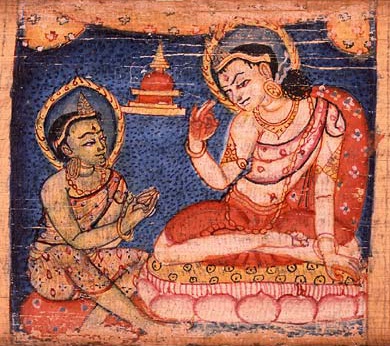|
Vairocana
Vairocana (from Sanskrit: Vi+rocana, "from the sun" or "belonging to the sun", "Solar", or "Shining"), also known as Mahāvairocana (Great Vairocana), is a major Buddha from Mahayana and Vajrayana Buddhism. Vairocana is often interpreted, in texts like the '' Avatamsaka Sutra'', as the Dharmakāya of the historical Gautama Buddha. In East Asian Buddhism ( Chinese, Korean, Japanese and Vietnamese Buddhism), Vairocana is also seen as the dharmakāya (the supreme buddha-body, the body of ultimate reality), and the embodiment of the Buddhist concept of wisdom and purity. Mahāvairocana is often translated into East Asian languages as "Great Sun Buddha" ( Chinese: 大日如來, pinyin: ''Dàrì Rúlái'', Japanese: ''Dainichi Nyorai''). In the conception of the Five Jinas of Mahayana and Vajrayana Buddhism, Vairocana is at the centre and is often considered a Primordial Buddha. In East Asian esoteric Buddhism, Mahāvairocana is considered to be a Cosmic Buddha whose body is th ... [...More Info...] [...Related Items...] OR: [Wikipedia] [Google] [Baidu] |
Buddhāvataṃsaka Sūtra
The ''Buddhāvataṃsaka-nāma-mahāvaipulya-sūtra (The Mahayana, Mahāvaipulya Sūtra named "Buddhāvataṃsaka")'' is one of the most influential Mahayana sutras, Mahāyāna sutras of East Asian Buddhism.Hamar, Imre. Buddhāvataṃsakasūtra, 2015, in ''Brill's Encyclopedia of Buddhism'' (Volume One), Handbook of Oriental Studies. Section 2 South Asia, Volume: 29-1. Editor-in-Chief: Jonathan Silk. It is often referred to in short as the '. In Classical Sanskrit, ''avataṃsa'', ''vataṃsa'' and ''uttaṃsa'' (from stem ''taṃs'', meaning "to decorate") all mean garland, wreath, or any circular ornament, such as an earring''''; suffix -ka often functions either as a diminutive or plural. Thus, the title may be rendered in English as ''A Garland of Buddhas'', ''Buddha Ornaments'', or ''Buddha's Fine Garland''. In Buddhist Hybrid Sanskrit, the term ''avataṃsaka'' means "a great number," "a multitude," or "a collection." This is matched by the Tibetan title of the sutra, wh ... [...More Info...] [...Related Items...] OR: [Wikipedia] [Google] [Baidu] |
Buddhahood
In Buddhism, Buddha (, which in classic Indo-Aryan languages, Indic languages means "awakened one") is a title for those who are Enlightenment in Buddhism, spiritually awake or enlightened, and have thus attained the Buddhist paths to liberation, supreme goal of Buddhism, variously described as Enlightenment in Buddhism, awakening or enlightenment (''bodhi''), ''Nirvana (Buddhism), Nirvāṇa'' ("blowing out"), and Moksha, liberation (''vimokṣa''). A Buddha is also someone who fully understands the ''Dharma, Dhārma'', the true nature of all things or Phenomenon, phenomena (''Abhidharma, dhārmata''), the Two truths doctrine, ultimate truth. Buddhahood (Sanskrit: ''buddhatva''; or ; zh, c=成佛) is the condition and state of being a Buddha. This highest spiritual state of being is also termed ''sammā-sambodhi'' (Sanskrit: ''samyaksaṃbodhi''; "full, complete awakening") and is interpreted in many different ways across schools of Buddhism. The title of "Buddha" is most c ... [...More Info...] [...Related Items...] OR: [Wikipedia] [Google] [Baidu] |
Mahayana
Mahāyāna ( ; , , ; ) is a term for a broad group of Buddhist traditions, Buddhist texts#Mahāyāna texts, texts, Buddhist philosophy, philosophies, and practices developed in ancient India ( onwards). It is considered one of the three main existing branches of Buddhism, the others being Theravāda and Vajrayāna.Harvey (2013), p. 189. Mahāyāna accepts the main scriptures and teachings of Early Buddhist schools, early Buddhism but also recognizes various doctrines and texts that are not accepted by Theravada Buddhism as original. These include the Mahāyāna sūtras and their emphasis on the ''bodhisattva'' path and Prajnaparamita, ''Prajñāpāramitā''. Vajrayāna or Mantra traditions are a subset of Mahāyāna which makes use of numerous Tantra, tantric methods Vajrayānists consider to help achieve Buddhahood. Mahāyāna also refers to the path of the bodhisattva striving to become a fully awakened Buddha for the benefit of all sentience, sentient beings, and is thus also ... [...More Info...] [...Related Items...] OR: [Wikipedia] [Google] [Baidu] |
Trikaya
The Trikāya (, lit. "three bodies"; , ) is a fundamental Buddhist doctrine that explains the multidimensional nature of Buddhahood. As such, the Trikāya is the basic theory of Mahayana Buddhist theology of Buddhahood. This concept posits that a Buddha has three distinct ''kayas'' or "bodies", aspects, or ways of being, each representing a different facet or embodiment of Buddhahood and ultimate reality. The three are the '' Dharmakāya'' (Sanskrit; Dharma body, the ultimate reality, the Buddha nature of all things), the ''Sambhogakāya'' (the body of self-enjoyment, a blissful divine body with infinite forms and powers) and the '' Nirmāṇakāya'' (manifestation body, the body which appears in the everyday world and presents the semblance of a human body). It is widely accepted in Buddhism that these three bodies are not separate realities, but functions, modes or "fluctuations" (Sanskrit: vṛṭṭis) of a single state of Buddhahood. The Trikāya doctrine explains how a Bu ... [...More Info...] [...Related Items...] OR: [Wikipedia] [Google] [Baidu] |
Brahmajāla Sūtra
The ' (), also called the ''Brahma's Net Sutra'', is a Mahayana Buddhist Vinaya Sutra. The Chinese translation can be found in the Taishō Tripiṭaka. The Tibetan translation can be found in Peking (Beijing) Kangyur 256. From the Tibetan it was also translated into Mongolian and the Manchu languages. It is known alternatively as the ' (). The ''Brahmajāla Sūtra'' is related to the important Huayan metaphor of Indra's net. It is not related to the '' Brahmajala Sutta'' of the Pāli Canon of Theravada Buddhism. History The sutra is traditionally regarded as having been recorded in Sanskrit and then translated into Chinese by Kumārajīva in 406. Several scholars assume that it was composed in East Asia by unknown authors in the mid-5th century, and is apocryphal.Cho, Eunsu. ''Fanwang jing'' in ''Macmillan Encyclopedia of Buddhism'', 2004, Volume One The sutra itself claims that it is part of a much longer Sanskrit text, but such a text has never been found. Qu Dache ... [...More Info...] [...Related Items...] OR: [Wikipedia] [Google] [Baidu] |
Gautama Buddha
Siddhartha Gautama, most commonly referred to as the Buddha (),* * * was a śramaṇa, wandering ascetic and religious teacher who lived in South Asia during the 6th or 5th century BCE and founded Buddhism. According to Buddhist legends, he was born in Lumbini, in what is now Nepal, to royal parents of the Shakya clan, but Great Renunciation, renounced his Householder (Buddhism), home life to live as a wandering ascetic. After leading a life of mendicancy, asceticism, and meditation, he attained Nirvana (Buddhism), nirvana at Bodh Gaya, Bodh Gayā in what is now India. The Buddha then wandered through the lower Indo-Gangetic Plain, teaching and building a Sangha, monastic order. Buddhist tradition holds he died in Kushinagar and reached ''parinirvana'' ("final release from conditioned existence"). According to Buddhist tradition, the Buddha taught a Middle Way between sensual indulgence and severe asceticism, leading to Vimutti, freedom from Avidyā (Buddhism), ignora ... [...More Info...] [...Related Items...] OR: [Wikipedia] [Google] [Baidu] |
Adi-Buddha
The Ādi-Buddha (, Ch: 本佛, Jp: honbutsu, First Buddha, Original Buddha, or Primordial Buddha) is a Mahayana Buddhist concept referring to the most fundamental, supreme, or ancient Buddha in the cosmos. Another common term for this figure is Dharmakāya Buddha. The term emerges in Tantras (Buddhism), tantric Buddhist literature, most prominently in the Kalachakra. "Ādi" means "first", such that the Ādibuddha was the first to attain Buddhahood. "Ādi" can also mean "primordial", not referring to a person but to an innate wisdom that is present in all sentient beings. In East Asian Buddhism, the term 本佛 (běn fó, original Buddha, root Buddha) also appears in the works of Tiantai and Tendai school, referring to the original Buddha of the ''Lotus Sutra'' which was also later identified with the cosmic Buddha Vairocana, Mahavairocana. It and similar terms were also used in the traditions of Chinese Esoteric Buddhism and Shingon Buddhism, Shingon to refer to the cosmic Budd ... [...More Info...] [...Related Items...] OR: [Wikipedia] [Google] [Baidu] |
Vajrayana
''Vajrayāna'' (; 'vajra vehicle'), also known as Mantrayāna ('mantra vehicle'), Guhyamantrayāna ('secret mantra vehicle'), Tantrayāna ('tantra vehicle'), Tantric Buddhism, and Esoteric Buddhism, is a Mahāyāna Buddhism, Mahāyāna Buddhist tradition that emphasizes Eastern esotericism, esoteric practices and rituals aimed at Sudden awakening, rapid spiritual awakening. Emerging between the 5th and 7th centuries CE in medieval India, Vajrayāna incorporates a Tibetan tantric practice, range of techniques, including the use of mantras (sacred sounds), dhāraṇīs (mnemonic codes), mudrās (symbolic hand gestures), mandalas (spiritual diagrams), and the visualization of Buddhist deities, deities and Buddhahood, Buddhas. These practices are designed to transform ordinary experiences into paths toward Enlightenment in Buddhism, enlightenment, often by engaging with aspects of Taṇhā, desire and Dvesha, aversion in a ritualized context. A distinctive feature of Vajrayāna is ... [...More Info...] [...Related Items...] OR: [Wikipedia] [Google] [Baidu] |
Chinese Buddhism
Chinese Buddhism or Han Buddhism ( zh, s=汉传佛教, t=漢傳佛教, first=t, poj=Hàn-thoân Hu̍t-kàu, j=Hon3 Cyun4 Fat6 Gaau3, p=Hànchuán Fójiào) is a Chinese form of Mahayana Buddhism. The Chinese Buddhist canonJiang Wu, "The Chinese Buddhist Canon" in ''The Wiley Blackwell Companion to East and Inner Asian Buddhism'', p. 299, Wiley-Blackwell (2014). draws from the traditions of Confucianism and Taoism as well as the rituals of local Chinese folk religion, folk religions. Chinese Buddhism emphasizes the study of Mahayana sutras and treatises. Some of the most important scriptures in Chinese Buddhism include the ''Lotus Sutra'', ''Avatamsaka Sutra, Flower Ornament Sutra'', Vimalakirti Sutra, ''Vimalakirtī Sutra'', ''Mahāyāna Mahāparinirvāṇa Sūtra, Nirvana Sutra,'' and Shorter Sukhāvatīvyūha Sūtra, ''Amitābha Sutra''. Chinese Buddhism is the largest institutionalized religion in mainland China.Cook, Sarah (2017). The Battle for China's Spirit: Religious R ... [...More Info...] [...Related Items...] OR: [Wikipedia] [Google] [Baidu] |
Dharmadhatu
Dharmadhatu (; ; ) is the 'dimension', 'realm' or 'sphere' (dhātu) of the Dharma or Absolute Reality. Entire Dharmadhatu was filled with an infinite number of buddha-lands (Sanskrit: buddhakṣetra) with ineffable number of Buddhas. This realm is beyond of everything, and it is visible only to Buddhas and all other Bodhisattvas in existence. Definition In Mahayana Buddhism, dharmadhatu means "realm of all phenomena", "realm of all things" (the entire universe with all visible and invisible things) or "realm of eternal truth". It is referred to by several analogous terms from Mahayana Buddhist philosophy, such as ''tathātā'' (reality "as-it-is"), ''śūnyatā'' (emptiness), '' pratitya-samutpada'' (dependent co-arising) and eternal Buddha. It is the "deepest nature, or essence". Dharmadhatu is the purified mind in its natural state, free of obscurations. It is the essence-quality or primal nature of mind, the fundamental ground of consciousness of the trikaya, which is acc ... [...More Info...] [...Related Items...] OR: [Wikipedia] [Google] [Baidu] |
Yoga Vasistha
''Vasishta Yoga Samhita'' (, IAST: '; also known as ''Mokṣopāya'' or ''Mokṣopāyaśāstra'', and as ''Maha-Ramayana'', ''Arsha Ramayana'', ''Vasiṣṭha Ramayana'', ''Yogavasistha-Ramayana'' and ''Jnanavasistha'', is a historically popular and influential syncretic philosophical text of Hinduism, dated to the 11th—14th century CE. According to Mainkar, writing in 1977, the text started as an Upanishad, which developed into the ''Laghu Vasistha'', incorporating Buddhist ideas, and then, between 1150 and 1250, the ''Yoga Vasistha'', incorporating Shaivite Trika ideas. According to Slaje, writing in the 2000s, the ''Mokṣopāya'' was written in Kashmir in the 10th century. According to Hanneder and Slaje, the ''Mokṣopāya'' was later (11th to the 14th century) modified, showing influences from the Saivite Trika school, resulting in the ''Yogavāsiṣṭha'', which became an orthodox text in Advaita Vedanta. The text is attributed to Maharishi Valmiki, but the real author ... [...More Info...] [...Related Items...] OR: [Wikipedia] [Google] [Baidu] |






